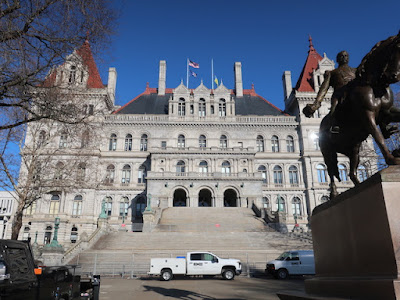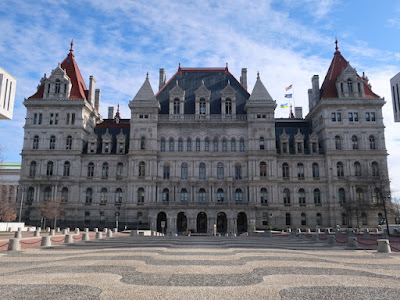The capital for the State of New York is far up the Hudson River in Albany. The Capitol is situated near the river in a large civic plaza. Like many other states, New York spent a great deal of money and time constructing the current building. Planning began in the late 1860s to replace the previous Capitol built in 1809. The groundbreaking was in 1867 but the project took a very long while. While he was governor, Teddy Roosevelt declared the Capitol completed in 1899, at which point the state had spent $25 million. Many restorations happened in the subsequent decades, especially after the 1911 fire.
We approached the building by East Capitol Park, though that entrance was closed for renovations.
 |
| East Capitol view |
We walked around to the State Street entrance, went through the typical security, and began a self-guided tour. The first thing we saw was a bust of Christopher Columbus!
 |
| Christopher Columbus |
Nearby is a portrait of George Washington, leader of the Revolutionary Army and first president of the country.
 |
| G. Washington |
Just under his portrait are two gigantic chain links. The nearby sign explained they were part of the Great Hudson Chain. In 1778, a large chain was put across the Hudson River from West Point to Constitution Island, effectively blocking British ships from sailing north along the Hudson.
 |
| Great Hudson Chain links |
We used the Senate Staircase to go up to the second floor. It certainly looks quite grand.
 |
| Stairwell of the Senate Staircase |
The Assembly (the other legislative body of the New York State government) has a staircase with a more Gothic and Moorish design that we also used to go up another level.
 |
| Assembly Staircase |
 |
| A bit of the decoration |
On the second floor, we saw the Governor's Reception Room with a ceiling mural depicting various battles that the state's citizens were involved in over the years. A circle of benches and chairs suggests a gathering area and provide a chance to sit and admire the ceiling. Originally, the floor was supposed to be taken out, creating a small rotunda, but the plan was abandoned. Now visitors can see the murals very closely!
 |
| Governor's Reception Room |
 |
| Ceiling mural |
 |
| State seal on the rug under the mural |
We were able to visit the Assembly Chamber. 150 assemblymen use the room to debate about and vote on laws. The room has a nice gallery and seating for invited visitors on the main floor.
 |
| Assembly Chamber |
 |
| Fancy lighting |
 |
| A clock from the exterior of the previous building |
 |
| Unused fireplaces in the back of the room |
The Senate Chamber is less accessible to visitors (at least on self-guided tours). I was able to take pictures from some third-floor windows. The state has sixty-three senators who would be meeting later that afternoon.
 |
| View into the Senate Chamber |
 |
| View from the other window |
The lobby of the Senate Chamber also has a clock (and a small bust of Franklin Delano Roosevelt).
 |
| Bust and Clock (a good pub name?) |
Also outside the Senate Chamber is one of the original desks that the 1880s senators used.
 |
| The original furniture |
We saw the third main staircase, the Great Western Staircase, but opted for the elevators to go back downstairs.
 |
| Great Western Staircase |
 |
| Skylight over the staircase |
The building is an amazing place to visit. There's a museum in the basement which we did not visit.
 |
| View from State Street |



No comments:
Post a Comment